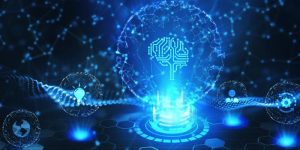Exploring the intersection of AI and human creativity and how to use AI generative tools responsibly.
Balancing Automation with Innovation and Responsibility in the Creative Process

AI can potentially revolutionise many industries; with its ability to process vast amounts of data quickly and accurately, AI can identify patterns and insights that humans may miss. For example, AI can help doctors diagnose diseases more accurately and efficiently or help financial analysts identify trends and investment opportunities. The keyword used in the previous sentence examples is ‘help’. For instance, we cannot rely solely on AI to diagnose our health issues in medicine. Medical professionals must always have the final word. By working with AI tools; healthcare professionals can provide better, more personalised care to their patients.
Any AI tool is only as accurate as the training data fed to it; the professional experience and knowledge of a doctor or a hedge fund manager are difficult, some would argue impossible, to teach to an AI. In this context, AI is extremely valuable as a profound source of factual information. With the caveat that AI responses can easily be incorrect, depending again on the data used for its training. Garbage in, garbage out is the rule.
Another of the biggest concerns is the potential for AI to perpetuate and even amplify existing biases and inequalities. Again, AI algorithms are only as good as the data they are trained on, and if that data is biased or incomplete, the algorithm will reflect those biases. For example, suppose an AI algorithm is trained on historical data that contains biases against certain racial or ethnic groups. In that case, the algorithm may perpetuate those biases in its recommendations or decisions.
AI can automate many tasks but cannot replace humans’ creativity and critical thinking skills. For example, an AI algorithm may be able to write a news article based on data and statistics. However, it cannot capture the nuance and complexity of human experience in the same way that a human writer can.
The question is, how can we use AI tools responsibly? The key is to ensure that human creativity is still valued and incorporated into the use of AI. This means encouraging creativity and innovation in using AI rather than simply using it as a tool for automation.
This article is a good example; when I started writing, it seemed clear what I wanted to say. But I quickly bogged down into an endless circle with no apparent way to escape it. So I used ChatGPT in this case to produce an outline for the article, which gave me new directions to explore and detail.
AI tools can generate creative content such as music or art. While this can be useful for generating ideas, it is essential to recognise that AI-generated content is not a substitute for human creativity. For example, human artists and musicians bring a unique perspective and emotional depth to their work that an algorithm cannot replicate.
To use AI tools responsibly, we must ensure they are transparent and accountable. This means that the algorithms used in AI tools should be open and accessible, and the decision-making processes should be explainable. This is essential in areas such as finance or criminal justice, where decisions made by AI tools can have a significant impact on people’s lives.
In the United States criminal justice system, AI tools predict the likelihood of reoffending or determining the length of a prison sentence. By contrast, these tools still need to be trusted by European legal systems. This is mainly because it is crucial to ensure that these tools are transparent and accountable and do not perpetuate existing biases or inequalities. A prerequisite that has yet to be satisfactorily met.
Tools
I’m currently experimenting with ChatGPT4, Microsoft Bing Chat and the Notion built-in AI tool. I am a Grammarly user, but I haven’t yet figured out how to access GrammarlyGO, even though it seems to be activated for my account.
These tools shine for me because of the creative assistance I receive when using well-thought-out prompts. This is an entirely new direction to take my creative business. We will see.
Final Thoughts
AI tools have the potential to transform many industries and provide significant benefits. But using these tools responsibly and recognising the importance of human creativity and critical thinking skills is essential.
By involving diverse groups of people in the development and use of AI, encouraging innovation and creativity, and ensuring transparency and accountability, we can harness the power of AI while minimising its potential drawbacks.
